https://www.youtube.com/watch?v=hvgspG-YZVw&ab_channel=InOurTime
https://www.youtube.com/watch?v=hvgspG-YZVw&ab_channel=InOurTime
Michael Thorne in The Raven:
How can one learn the truth by thinking? As one learns to see a face better if one draws it.
Ludwig Wittgenstein, Zettel §255
 This remark, like many of Wittgenstein’s, seems to arise from self-examination. The answer he gives suggests that he is concerned with learning just by thinking, and indeed with the particular kind of learning just by thinking that happens in philosophy (as opposed to, say, mathematics). He seems to be asking how such learning is even possible. What are we to make of his answer?
This remark, like many of Wittgenstein’s, seems to arise from self-examination. The answer he gives suggests that he is concerned with learning just by thinking, and indeed with the particular kind of learning just by thinking that happens in philosophy (as opposed to, say, mathematics). He seems to be asking how such learning is even possible. What are we to make of his answer?
I remember being surprised when I was taught where to place the eyes when drawing a face seen from straight on. I thought I knew where the eyes went: about three-quarters of the way up. But when I really looked at a face in order to draw it, I saw that I was wrong: the eyes are halfway down the head.
This is the sort of thing one might call “learning to see a face better by drawing it.” I thought I knew how something looked, but to produce a good drawing, I had to really look—and in doing so I discovered that I didn’t know how it looked, after all.
More here.
Robin McKie in The Guardian:
 At the centre of the Earth, a giant sphere of solid iron is slowly swelling. This is the inner core and scientists have recently uncovered intriguing evidence that suggests its birth half a billion years ago may have played a key role in the evolution of life on Earth.
At the centre of the Earth, a giant sphere of solid iron is slowly swelling. This is the inner core and scientists have recently uncovered intriguing evidence that suggests its birth half a billion years ago may have played a key role in the evolution of life on Earth.
At that time, our planet’s magnetic field was faltering – and that would have had critical consequences, they argue. Normally this field protects life on the surface by repelling cosmic radiation and charged particles emitted by our sun.
But 550m years ago, it had dropped to a fraction of its current strength – before it abruptly regained its power. And in the wake of this planetary reboot, Earth witnessed the sudden proliferation of complex multicellular life on its surface. This was the Cambrian explosion, when most major animal groups first appeared in the fossil record. Now scientists have linked it to events at the very centre of the Earth.
More here.
Noah Smith in his Substack newsletter:
 I’ve been writing a series of posts about economic development. The last 20 years have seen a marked acceleration in the rate at which poorer countries — not just China, but many countries — are catching up to richer ones. Among the success stories I’ve profiled so far are Bangladesh, the Dominican Republic, and Poland. But today I want to talk about the country that might impress me more than any of the others: Indonesia.
I’ve been writing a series of posts about economic development. The last 20 years have seen a marked acceleration in the rate at which poorer countries — not just China, but many countries — are catching up to richer ones. Among the success stories I’ve profiled so far are Bangladesh, the Dominican Republic, and Poland. But today I want to talk about the country that might impress me more than any of the others: Indonesia.
Indonesia’s growth has been solid, but not amazing. Compared to its Southeast Asian neighbors, it’s pretty middle-of-the pack in terms of both the growth rate — an increase of 160% since 1990 — and in terms of per capita GDP. At around $11,000 a person, Indonesia is solidly in the middle-income category.
So why do I find Indonesia to be such an impressive growth story? Well, several reasons. But first of all, the deck was really stacked against Indonesia in a number of ways.
More here.
PD Smith in The Guardian:
 In Laurence Sterne’s 1759 novel Tristram Shandy, the hero describes how his good-natured uncle Toby is plagued by a particularly large and annoying fly which “buzzed about his nose, and tormented him cruelly all dinner time”. Eventually he manages to catch the offending insect, but instead of killing it, he releases it out of the window. “Why should I hurt thee?” he says. “This world surely is wide enough to hold both thee and me.” The novel’s hero is a child at the time, but this “lesson of universal good-will” leaves an abiding impression on him, setting, as he put it “my whole frame into one vibration of most pleasurable sensation”. Karen Armstrong cites this act of kindness at the end of a chapter exploring the crucial role played by the ancient concept of ahimsa in Indian spiritual traditions. Meaning “harmlessness”, it prohibits any kind of injury to others and was one of the core principles that aspirants in yoga had to observe.
In Laurence Sterne’s 1759 novel Tristram Shandy, the hero describes how his good-natured uncle Toby is plagued by a particularly large and annoying fly which “buzzed about his nose, and tormented him cruelly all dinner time”. Eventually he manages to catch the offending insect, but instead of killing it, he releases it out of the window. “Why should I hurt thee?” he says. “This world surely is wide enough to hold both thee and me.” The novel’s hero is a child at the time, but this “lesson of universal good-will” leaves an abiding impression on him, setting, as he put it “my whole frame into one vibration of most pleasurable sensation”. Karen Armstrong cites this act of kindness at the end of a chapter exploring the crucial role played by the ancient concept of ahimsa in Indian spiritual traditions. Meaning “harmlessness”, it prohibits any kind of injury to others and was one of the core principles that aspirants in yoga had to observe.
But ahimsa was taken most seriously by the Jains, whose religious tradition was founded by Vardhamana Jnatiputra in the fifth century BC. He taught that it was not only humans who had a jiva (soul), but also every animal, plant and rock, as well as water, fire and air. It followed that all these things should be treated with the same courtesy and respect that we would wish to receive. This radical empathy meant that Jains avoided killing any insect or plant, and twice a day they asked for forgiveness for any creature they might have inadvertently injured or destroyed: “May all creatures pardon me. May I have friendship with all creatures and enmity toward none.”
More here.
Allie Volpe in Vox:
 Julia Strand was confident in her scientific findings when they were published in 2018. Strand’s research showed that when a circular beacon of light was present in a noisy setting, people expended less energy listening to their conversation partner and responded quicker than without the light. The feedback was positive and Strand, an associate professor of psychology at Carleton College in Northfield, Minnesota, had received grant funding to continue her research. Some months later, however, Strand was unable to replicate her results. In fact, she found the opposite to be true: The light forced people to think harder. Strand had crossed her t’s, dotted her i’s, and showed her work — and still she was wrong. “The bottom dropped out of my stomach,” Strand says. “It was terrible to realize that I had not just made a mistake, but published a mistake.”
Julia Strand was confident in her scientific findings when they were published in 2018. Strand’s research showed that when a circular beacon of light was present in a noisy setting, people expended less energy listening to their conversation partner and responded quicker than without the light. The feedback was positive and Strand, an associate professor of psychology at Carleton College in Northfield, Minnesota, had received grant funding to continue her research. Some months later, however, Strand was unable to replicate her results. In fact, she found the opposite to be true: The light forced people to think harder. Strand had crossed her t’s, dotted her i’s, and showed her work — and still she was wrong. “The bottom dropped out of my stomach,” Strand says. “It was terrible to realize that I had not just made a mistake, but published a mistake.”
Being wrong is an unavoidable aspect of the human condition. Defining what constitutes “wrong,” however, can get messy. People can be wrong about any multitude of things, from misremembering the name of a ’90s pop song to incorrectly casting blame onto a friend during a heated argument. Mistakes happen on scales big and small, topics tangible and moral or ethical. In the 2010 book Being Wrong: Adventures in the Margin of Error, author Kathryn Schulz loosely defines being wrong “as a deviation from external reality, or an internal upheaval in what we believe” — with the caveat that wrongness is too vast to fit neatly into either category.
More here.
Richard J. Powell at Artforum:
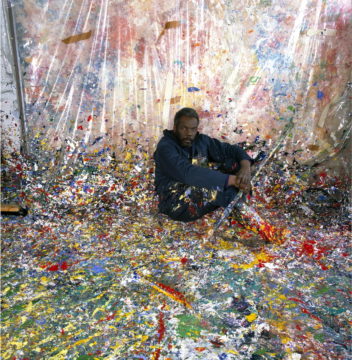 ALTHOUGH the more-than-a-half-century career of abstract painter Sam Gilliam was universally recognized and expansive in its reach, his studio and home were in Washington, D.C., which the art world was late to recognize as a place for innovative art and shape-shifting artists. Despite the history surrounding the genesis and development of the Washington Color School—chronicles that include such luminaries as critic Clement Greenberg and painters Morris Louis and Kenneth Noland—the reputation of the nation’s capital for nurturing leading-edge visual artists pales in comparison to cities like New York, Chicago, and Los Angeles. And yet Sam Gilliam’s groundbreaking creations, from his draped canvases to his acrylic-laden structures, cannot be separated from the town that, until recently, was euphemistically referred to as Chocolate City, a setting with an idiosyncratic, generative mixture of bureaucratic precedent, cosmopolitan rapprochement, and African American artistry.
ALTHOUGH the more-than-a-half-century career of abstract painter Sam Gilliam was universally recognized and expansive in its reach, his studio and home were in Washington, D.C., which the art world was late to recognize as a place for innovative art and shape-shifting artists. Despite the history surrounding the genesis and development of the Washington Color School—chronicles that include such luminaries as critic Clement Greenberg and painters Morris Louis and Kenneth Noland—the reputation of the nation’s capital for nurturing leading-edge visual artists pales in comparison to cities like New York, Chicago, and Los Angeles. And yet Sam Gilliam’s groundbreaking creations, from his draped canvases to his acrylic-laden structures, cannot be separated from the town that, until recently, was euphemistically referred to as Chocolate City, a setting with an idiosyncratic, generative mixture of bureaucratic precedent, cosmopolitan rapprochement, and African American artistry.
more here.
Brad East at the LARB:
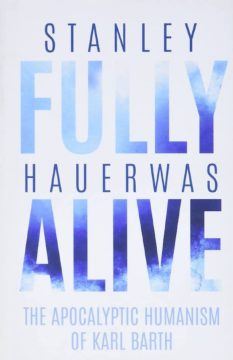 THIS YEAR STANLEY Hauerwas turns 82 years old. To mark the occasion, he has published a book on Karl Barth, who died at the same age in 1968. The timing as well as the pairing is fitting. Barth is the greatest Protestant theologian of the 20th century, and probably the most widely read of any theologian over the last 100 years. As for Hauerwas, since the passing of Reinhold Niebuhr in 1971, he has been the most prolific, influential, and recognizable Christian theological thinker in American public life. Barth somehow graced the cover of Time magazine in 1962, even though he was a Swiss Calvinist whose books on technical theology are so thick they could stop bullets. Hauerwas has never made the cover, but in 2001 Time did call him “America’s best theologian.” That fall, Oprah even invited him onto her show. In short, given Hauerwas’s age and stature, Fully Alive: The Apocalyptic Humanism of Karl Barth has the inevitable feel of a valediction.
THIS YEAR STANLEY Hauerwas turns 82 years old. To mark the occasion, he has published a book on Karl Barth, who died at the same age in 1968. The timing as well as the pairing is fitting. Barth is the greatest Protestant theologian of the 20th century, and probably the most widely read of any theologian over the last 100 years. As for Hauerwas, since the passing of Reinhold Niebuhr in 1971, he has been the most prolific, influential, and recognizable Christian theological thinker in American public life. Barth somehow graced the cover of Time magazine in 1962, even though he was a Swiss Calvinist whose books on technical theology are so thick they could stop bullets. Hauerwas has never made the cover, but in 2001 Time did call him “America’s best theologian.” That fall, Oprah even invited him onto her show. In short, given Hauerwas’s age and stature, Fully Alive: The Apocalyptic Humanism of Karl Barth has the inevitable feel of a valediction.
more here.
Robert Paul Wolff in his own blog:
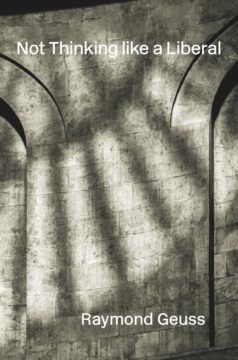 Several days ago, I received from Raymond Geuss a copy of his new book, Not Thinking like a Liberal, which has just been published by Harvard. It is an intense, complex, deeply interior account of his philosophical development first as a boy in a Catholic private school and then as an undergraduate and graduate student at Columbia University. Geuss, as I am sure you all know, is a distinguished philosopher now retired from Cambridge University, the author of a number of books.
Several days ago, I received from Raymond Geuss a copy of his new book, Not Thinking like a Liberal, which has just been published by Harvard. It is an intense, complex, deeply interior account of his philosophical development first as a boy in a Catholic private school and then as an undergraduate and graduate student at Columbia University. Geuss, as I am sure you all know, is a distinguished philosopher now retired from Cambridge University, the author of a number of books.
Geuss and I come from backgrounds so different from one another that it is hard to believe we could ever inhabit the same world and yet, for a span of time in the 1960s and a little bit beyond, our lives intersected on the seventh floor of Philosophy Hall at Columbia University. Geuss arrived at Columbia as a 16-year-old freshman in 1963, graduated summa cum laude, and earned his doctorate in the philosophy department in 1971. I joined the philosophy department as an associate professor in 1964 and resigned my professorship to go to the University of Massachusetts in 1971. Both of us took the year 1967 – 68 off from Columbia, I to teach at Rutgers while continuing to live across the street from the Columbia campus and he to spend the year in Germany.
In this book, Ray gives an intense contemplative complexly thought through account of the life process by which he arrived eventually at the condition he describes as “not thinking like a liberal,” beginning with his education at a Catholic boarding school outside of Philadelphia staffed in large part by Hungarian priests who had fled the communist regime.
More here.
Emma Yasinski in Undark:
 It’s “appalling” that more scientists — whether they’re studying endometriosis or not — aren’t studying menstrual blood, which contains a combination of blood and tissue that lines the uterus, said Metz. Researchers routinely examine saliva, mouth tissue, skin, and even teeth, looking for clues about health and disease. By contrast, said Metz, menstrual effluent has been neglected.
It’s “appalling” that more scientists — whether they’re studying endometriosis or not — aren’t studying menstrual blood, which contains a combination of blood and tissue that lines the uterus, said Metz. Researchers routinely examine saliva, mouth tissue, skin, and even teeth, looking for clues about health and disease. By contrast, said Metz, menstrual effluent has been neglected.
Metz is one of a handful of scientists worldwide studying menstrual blood; these researchers are looking into its potential as a diagnostic marker for diabetes, gynecologic diseases, and even toxic exposures. Because the work is still new, it could be years, even decades, before any findings influence clinical care. For now, however, the researchers are challenging the conventional view that menstrual blood is merely a waste product. Instead, they said, careful examination of this biological specimen may yield important insights into health and disease.
More here.
Scott Atran in Aeon:
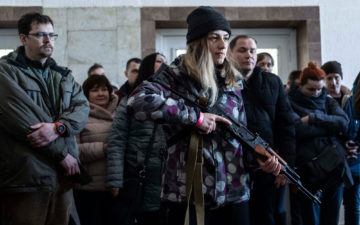 Throughout history, the most effective combatants, revolutionaries and insurgents have been ‘devoted actors’ fused together by dedication to non-negotiable ‘sacred values’ such as God, country or liberty. Military incursions nearly always plan for maximum force at the beginning to ensure victory. But if defenders resist, or are allowed to recoup, then the advantage often shifts to those with the will to fight as they increasingly harness resources against their attackers who are maxed-out in terms of what they are able, or willing, to commit: consider Napoleon and then Hitler and their onslaught against Russia, or the United States’ invasions of Iraq and Afghanistan. Throughout history, those willing to sacrifice for cause and comrades, and for their leaders, have often prevailed against more powerful forces that mainly rely on material incentives such as pay and punishment.
Throughout history, the most effective combatants, revolutionaries and insurgents have been ‘devoted actors’ fused together by dedication to non-negotiable ‘sacred values’ such as God, country or liberty. Military incursions nearly always plan for maximum force at the beginning to ensure victory. But if defenders resist, or are allowed to recoup, then the advantage often shifts to those with the will to fight as they increasingly harness resources against their attackers who are maxed-out in terms of what they are able, or willing, to commit: consider Napoleon and then Hitler and their onslaught against Russia, or the United States’ invasions of Iraq and Afghanistan. Throughout history, those willing to sacrifice for cause and comrades, and for their leaders, have often prevailed against more powerful forces that mainly rely on material incentives such as pay and punishment.
More here.
Joseph Epstein in Commentary:
 Fortunate is the person who has reached the age of 50 without having had to grieve. To be among the grieving, the bereaved, is an experience most of us go through, excepting only those who die preternaturally young and are themselves the cause of bereavement. The death of a parent, a husband or wife, a brother or sister, a dear friend, in some ways saddest of all, a child, is among the major causes of grief. May grief be avoided? Ought it to be? Is there any sense in which, as Charlie Brown’s favorite phrase had it, there is good grief?
Fortunate is the person who has reached the age of 50 without having had to grieve. To be among the grieving, the bereaved, is an experience most of us go through, excepting only those who die preternaturally young and are themselves the cause of bereavement. The death of a parent, a husband or wife, a brother or sister, a dear friend, in some ways saddest of all, a child, is among the major causes of grief. May grief be avoided? Ought it to be? Is there any sense in which, as Charlie Brown’s favorite phrase had it, there is good grief?
Socrates held that one of the key missions of philosophy was to ward off our fear of death. Upon his own death, by self-imposed hemlock, he claimed to be looking forward at long last to discovering whether there was an afterlife. Montaigne wrote an essay called “To Philosophize Is to Learn How to Die,” in which, as elsewhere in his essays, he argues that, far from putting death out of mind, we should keep it foremost in our minds, the knowledge of our inevitably forthcoming death goading us on the better to live our lives.
More here.
Alexandra Witz in Nature:
 The views of the Universe just keep getting better. NASA’s US$10-billion James Webb Space Telescope released four new scientific images on 12 July, including newborn stars sparkling through dramatic ‘cliffs’ of gas, and galaxies interacting in an intricate cosmic dance. A day earlier, astronomers had marveled at its very first image, a mind-boggling deep dive into the distant Universe.
The views of the Universe just keep getting better. NASA’s US$10-billion James Webb Space Telescope released four new scientific images on 12 July, including newborn stars sparkling through dramatic ‘cliffs’ of gas, and galaxies interacting in an intricate cosmic dance. A day earlier, astronomers had marveled at its very first image, a mind-boggling deep dive into the distant Universe.
Webb observes the cosmos in infrared wavelengths, which gives it a different view than many other observatories, such as the Hubble Space Telescope. Webb’s 6.5-metre-wide mirror is the largest ever launched into space, and the combination of the large mirror and its infrared detection capabilities allow Webb an unprecedented view of many astronomical phenomena. That includes stars and shock waves generated as galaxies collide in the group of five known as Stephan’s Quintet, 90 million parsecs away in the constellation Pegasus. The images that Webb collected of the galaxy grouping reveal millions of young stars forming as gas and dust collide, as well as sweeping tails left by one of the galaxies, NGC 7318B, as it storms its way through the cluster. “It really shows the type of interaction that drives the evolution of galaxies,” says Giovanna Giardino, an astronomer with the European Space Agency.
More here.
They have photographed the brain
and here is the picture, it is full of
branches as I always expected,
each time you arrive the electricity
of seeing you is a huge
tree lumbering through my skull, the roots waving.
It is an earth, its fibers wrap
things buried, your forgotten words
are graved in my head, an intricate
red blue and pink prehensile chemistry
veined like a leaf
network, or is it a seascape
with corals and shining tentacles.
I touch you, I am created in you
somewhere as a complex
filament of light
by Margaret Atwood
from Margaret Atwood Selected Poems
Oxford University Press, 1976
Justin E. H. Smith in Liberties:
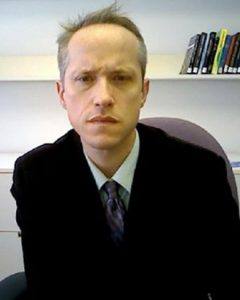 What is a game? Ludwig Wittgenstein famously chose this nebulous concept to illustrate what he meant by “family resemblance,” where the individual members of a class can be determined to fulfill no necessary and sufficient conditions for admission, and instead only share some traits with some others in the class, others with others. Yet we can at least identify two types of game, which seem not just distinct from one another but very nearly opposite. One class of games, which includes peek-a-boo, charades, and musical improvisation as representative instances, is characterized by free expressivity. It is the manifestation of what Friedrich Schiller called the Spieltrieb, the “play-drive,” which is innate in all human beings insofar as they are free. The other class includes chess, fencing, and wargames as its representative instances. If there is still some dose of freedom operating in this sort of game, it is freedom under severe constraints. The purpose here is to win, and one does so by means of strategy aforethought. In such games, serendipity and spontaneity are disadvantages. While some such games may, like Schillerian free play, be “fun” (especially when you win and the other guy loses), at their outer edge they shade over into a domain of human endeavor that has little to do with leisure at all. At their most serious they can determine the fate of the world.
What is a game? Ludwig Wittgenstein famously chose this nebulous concept to illustrate what he meant by “family resemblance,” where the individual members of a class can be determined to fulfill no necessary and sufficient conditions for admission, and instead only share some traits with some others in the class, others with others. Yet we can at least identify two types of game, which seem not just distinct from one another but very nearly opposite. One class of games, which includes peek-a-boo, charades, and musical improvisation as representative instances, is characterized by free expressivity. It is the manifestation of what Friedrich Schiller called the Spieltrieb, the “play-drive,” which is innate in all human beings insofar as they are free. The other class includes chess, fencing, and wargames as its representative instances. If there is still some dose of freedom operating in this sort of game, it is freedom under severe constraints. The purpose here is to win, and one does so by means of strategy aforethought. In such games, serendipity and spontaneity are disadvantages. While some such games may, like Schillerian free play, be “fun” (especially when you win and the other guy loses), at their outer edge they shade over into a domain of human endeavor that has little to do with leisure at all. At their most serious they can determine the fate of the world.
It is this latter sort of game alone that machines are capable of “understanding.”
More here.
Sean Carroll in Preposterous Universe:
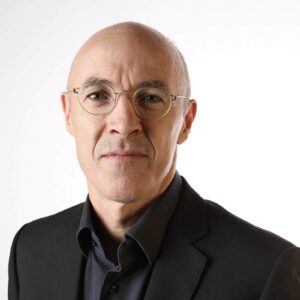 We describe the world using language — we can’t help it. And we all know that ordinary language is an imperfect way of communicating rigorous scientific statements, but sometimes it’s the best we can do. Linguist N.J. Enfield argues that the difficulties run more deeply than we might ordinarily suppose. We use language as a descriptive tool, but its origins are found in more social practices — communicating with others to express our feelings and persuade them to agree with us. As such, the very structure of language itself reflects these social purposes, and we have to be careful not to think it provides an unfiltered picture of reality.
We describe the world using language — we can’t help it. And we all know that ordinary language is an imperfect way of communicating rigorous scientific statements, but sometimes it’s the best we can do. Linguist N.J. Enfield argues that the difficulties run more deeply than we might ordinarily suppose. We use language as a descriptive tool, but its origins are found in more social practices — communicating with others to express our feelings and persuade them to agree with us. As such, the very structure of language itself reflects these social purposes, and we have to be careful not to think it provides an unfiltered picture of reality.
More here.